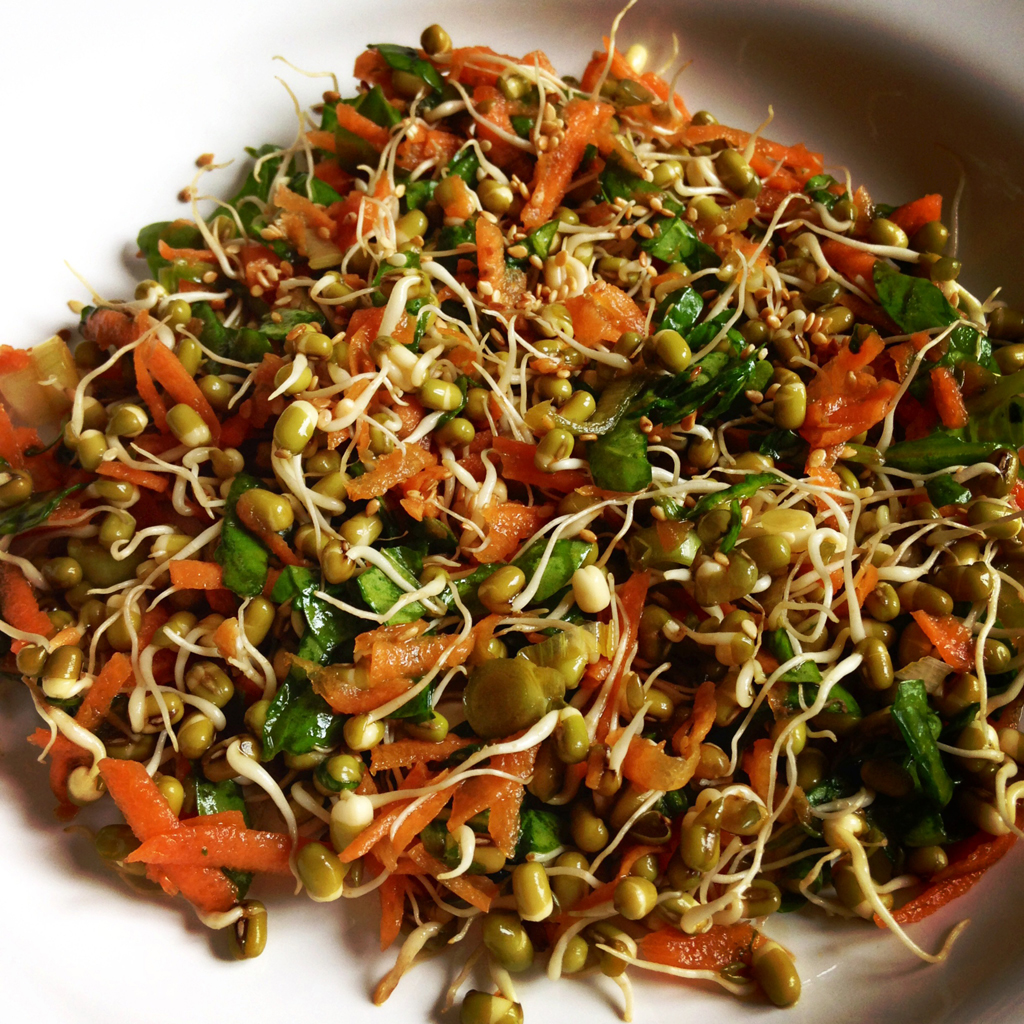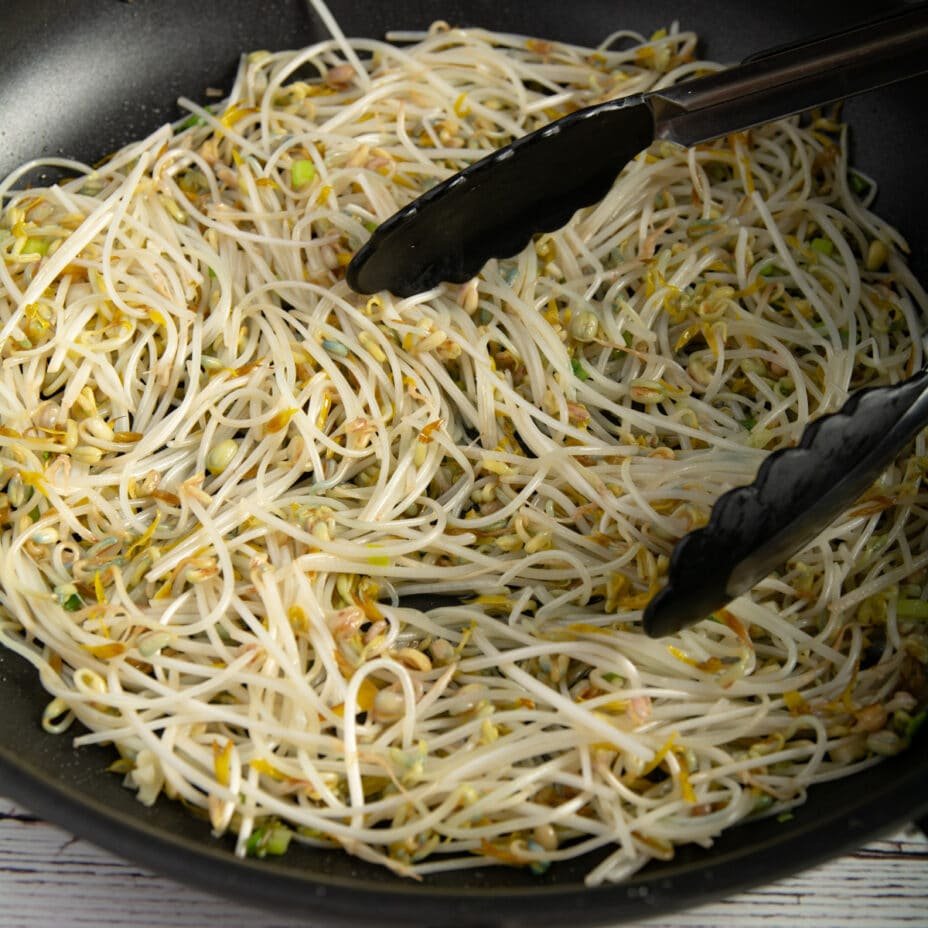Mung bean sprouts, a nutritional powerhouse, have captivated culinary enthusiasts for centuries, gracing cuisines worldwide with their crisp texture and delicate flavor. Embark on a culinary journey as we delve into the art of preparing mung bean sprouts, exploring their health benefits, cultural significance, and endless culinary applications.
From simple stir-fries to vibrant salads, discover the versatility of this humble ingredient and unlock a world of culinary possibilities.
Whether you’re a seasoned chef or a home cook seeking to expand your culinary horizons, this guide will equip you with the knowledge and inspiration to incorporate mung bean sprouts into your daily meals. Join us as we explore the secrets of preparing this nutritious superfood, unlocking its potential to enhance your health and culinary creations.
Ingredients
Mung bean sprouts, the delectable edible sprouts of mung beans, are a culinary delight in many cuisines around the world. Their versatility allows for various cooking methods, making them a staple in stir-fries, salads, soups, and even as a garnish.
To create delectable mung bean sprout dishes, a few essential ingredients are necessary:
-
-*Mung bean sprouts
The star ingredient, mung bean sprouts, should be fresh and crisp, with no signs of wilting or discoloration.
-*Aromatics
Aromatics such as garlic, ginger, and shallots add depth of flavor to the dish.
-*Sauce
A flavorful sauce is essential to bind the ingredients and enhance the taste. Soy sauce, fish sauce, or oyster sauce are common choices.
-*Seasonings
Salt and pepper are the basic seasonings, but you can also add other spices like chili powder, cumin, or coriander to taste.
Variations in Ingredients
Regional and cultural cuisines influence the ingredients used in mung bean sprout recipes.
For example:
-
-*Chinese cuisine
Chinese-style mung bean sprout dishes often include ingredients like fermented black beans, sesame oil, and Shaoxing wine.
-*Thai cuisine
Thai mung bean sprout dishes may incorporate lemongrass, kaffir lime leaves, and chili peppers for a vibrant flavor profile.
-*Indian cuisine
Indian mung bean sprout recipes might include cumin, turmeric, and garam masala for a warm and aromatic taste.
Complementary Ingredients
Complementary ingredients can further enhance the flavor of mung bean sprouts. These include:
-
-*Vegetables
Vegetables like carrots, celery, and bell peppers add texture and color to the dish.
-*Protein
Tofu, chicken, or shrimp can add protein and make the dish more substantial.
-*Herbs
Fresh herbs like cilantro, basil, or mint add a refreshing touch to the dish.
Preparation
Mung bean sprouts require minimal preparation before cooking. The process involves soaking, draining, and removing the hulls to enhance their texture and flavor.
Soaking and Draining
Soak the mung beans in a bowl of cold water for 6-8 hours or overnight. Drain the water and rinse the sprouts thoroughly. Repeat this process 2-3 times to remove any impurities or remaining hulls.
Removing the Hulls
After soaking and draining, use your fingers to gently rub the sprouts together. This action will loosen the hulls, which can then be easily removed by blowing them away or using a fan.
Tips for Crispness
To maintain the crispness of the sprouts, store them in a damp paper towel in the refrigerator. Change the paper towel regularly to prevent spoilage. Additionally, avoid overcooking the sprouts, as this can make them mushy.
Cooking Methods
Steaming
Steaming mung bean sprouts is a gentle method that preserves their delicate texture and nutrients. The sprouts are placed in a steamer basket over boiling water and cooked until tender-crisp, usually within 5-7 minutes. Steamed sprouts are ideal for salads, stir-fries, and soups.
Boiling
Boiling mung bean sprouts is a quick and easy way to cook them. The sprouts are added to a pot of boiling water and cooked for 1-2 minutes, or until they turn bright green and tender. Boiled sprouts are suitable for salads, soups, and curries.
Stir-frying
Stir-frying mung bean sprouts is a popular method in Asian cuisine. The sprouts are added to a hot wok or skillet with other ingredients, such as vegetables, meat, or tofu, and stir-fried until tender and slightly browned. Stir-fried sprouts add a crunchy texture and fresh flavor to dishes.
Microwaving
Microwaving mung bean sprouts is a convenient method for small quantities. The sprouts are placed in a microwave-safe container with a splash of water and cooked on high power for 1-2 minutes, or until heated through. Microwaved sprouts are best used in dishes where they will be cooked further, such as soups or stir-fries.
Nutritional Value

Mung bean sprouts are a nutritional powerhouse, boasting an impressive array of vitamins, minerals, and antioxidants.
They are rich in vitamin C, an essential nutrient for immune system function and antioxidant protection. Additionally, they contain vitamin K, which is crucial for blood clotting and bone health.
Minerals
- Mung bean sprouts are a good source of iron, which is essential for red blood cell production and oxygen transport.
- They also contain magnesium, which supports muscle function, nerve transmission, and blood sugar regulation.
- Potassium, another abundant mineral in mung bean sprouts, plays a vital role in maintaining electrolyte balance and regulating blood pressure.
Antioxidants
Mung bean sprouts are a rich source of antioxidants, including flavonoids and phenolic acids. These compounds help protect cells from damage caused by free radicals, which can contribute to chronic diseases such as cancer and heart disease.
Cultural Significance
Mung bean sprouts hold significant cultural importance in various cuisines worldwide, embodying diverse culinary traditions and symbolic meanings.
In many Asian cultures, mung bean sprouts symbolize prosperity, fertility, and longevity. They are often incorporated into dishes during festivals and celebrations to bring good fortune and well-being.
Traditional Uses
Traditionally, mung bean sprouts have been used in soups, salads, stir-fries, and as a garnish in various dishes. In Chinese cuisine, they are a staple ingredient in spring rolls, soups, and stir-fries. In Thai cuisine, they are commonly used in salads, curries, and stir-fries.
In Vietnamese cuisine, they are a key ingredient in the popular dish “pho” (beef noodle soup).
Cultural Dishes
Some notable cultural dishes that prominently feature mung bean sprouts include:
- Pad See Ew (Thailand): A stir-fried noodle dish with mung bean sprouts, vegetables, and a sweet soy sauce.
- Som Tum (Thailand): A spicy green papaya salad with mung bean sprouts, tomatoes, and peanuts.
- Banh Xeo (Vietnam): A crispy crepe filled with pork, shrimp, and mung bean sprouts.
- Yakisoba (Japan): A stir-fried noodle dish with mung bean sprouts, vegetables, and meat.
Recipes
Mung Bean Sprout Recipes from Around the World
Mung bean sprouts are a versatile ingredient that can be used in a variety of dishes. Here are a few recipes from different cuisines that showcase the many ways to enjoy this healthy and delicious vegetable.
| Recipe | Cuisine | Ingredients | Cooking Time |
|---|---|---|---|
| Stir-fried Mung Bean Sprouts | Chinese | Mung bean sprouts, garlic, ginger, soy sauce, sesame oil | 10 minutes |
| Mung Bean Sprout Salad | Thai | Mung bean sprouts, carrots, cucumber, onion, peanuts, lime juice, fish sauce | 15 minutes |
| Mung Bean Sprout Curry | Indian | Mung bean sprouts, onions, tomatoes, garlic, ginger, turmeric, cumin, coriander | 30 minutes |
| Mung Bean Sprout Soup | Korean | Mung bean sprouts, beef broth, garlic, ginger, soy sauce, sesame oil | 20 minutes |
| Mung Bean Sprout Tacos | Mexican | Mung bean sprouts, tortillas, black beans, corn, salsa, avocado | 15 minutes |
Health Benefits
Mung bean sprouts are not only delicious but also packed with an array of health benefits. Their nutritional composition makes them an excellent addition to a healthy diet.
One of the most notable benefits of mung bean sprouts is their ability to reduce cholesterol levels. Studies have shown that the soluble fiber in these sprouts binds to cholesterol in the digestive tract, preventing it from being absorbed into the bloodstream.
This can help lower overall cholesterol levels and reduce the risk of heart disease.
Digestive Health
Mung bean sprouts are also beneficial for digestive health. They are a good source of dietary fiber, which helps to promote regularity and prevent constipation. Additionally, the enzymes in mung bean sprouts aid in the digestion of proteins and carbohydrates, making them easier to absorb.
Weight Management
Mung bean sprouts can support weight management efforts. They are low in calories and high in fiber, which helps to promote a feeling of fullness and reduce overall calorie intake. Additionally, the fiber in mung bean sprouts helps to regulate blood sugar levels, preventing spikes and crashes that can lead to overeating.
Culinary Applications

Mung bean sprouts are versatile culinary ingredients, adding a crisp texture and fresh flavor to a wide range of dishes. Their mild taste makes them a suitable addition to various cuisines.
Salads
In salads, mung bean sprouts provide a refreshing crunch and nutritional boost. They pair well with leafy greens, vegetables, and fruits. Consider adding them to Asian-inspired salads with dressings like sesame-ginger or soy-lime.
Stir-fries
Mung bean sprouts are a staple in stir-fries, contributing a crisp contrast to the tender meats and vegetables. Their ability to absorb flavors makes them an ideal ingredient for flavorful stir-fries.
Soups
In soups, mung bean sprouts add a delicate texture and a subtle nutty flavor. They can be added to clear broths, hearty stews, or flavorful miso soups.
Other Dishes
Mung bean sprouts can also be used in spring rolls, salads, sandwiches, and as a garnish for various dishes. Their versatility extends to both cooked and raw preparations, making them a convenient ingredient to have on hand.
Outcome Summary
In conclusion, mung bean sprouts stand as a testament to the power of simple ingredients, offering a wealth of nutritional benefits and culinary versatility. Embracing their unique flavor and texture will not only elevate your dishes but also contribute to your overall well-being.
So, next time you seek a healthy and flavorful addition to your meals, reach for a handful of mung bean sprouts and embark on a culinary adventure that will leave you craving more.
FAQ Corner
How long should I soak mung bean sprouts before cooking?
Soaking time varies depending on the desired level of crispness. For a crunchy texture, soak for 4-6 hours. For a softer sprout, soak for 8-12 hours or overnight.
How do I remove the hulls from mung bean sprouts?
Gently rub the sprouts between your fingers or use a kitchen towel to loosen the hulls. Rinse thoroughly to remove any remaining hulls.
Can I freeze mung bean sprouts?
Yes, mung bean sprouts can be frozen for up to 6 months. Blanch them for 2 minutes, drain well, and freeze in airtight containers.
What are some creative ways to use mung bean sprouts?
Incorporate them into salads, stir-fries, soups, and curries. Try sprouting them in different flavors, such as soy sauce or miso, for added depth.
